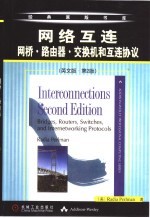图书介绍
网络互连 网桥·路由器·交换机和互连协议 英文版PDF|Epub|txt|kindle电子书版本网盘下载

- (美)Radia Perlman著 著
- 出版社: 北京:机械工业出版社
- ISBN:7111095065
- 出版时间:2002
- 标注页数:537页
- 文件大小:19MB
- 文件页数:552页
- 主题词:
PDF下载
下载说明
网络互连 网桥·路由器·交换机和互连协议 英文版PDF格式电子书版下载
下载的文件为RAR压缩包。需要使用解压软件进行解压得到PDF格式图书。建议使用BT下载工具Free Download Manager进行下载,简称FDM(免费,没有广告,支持多平台)。本站资源全部打包为BT种子。所以需要使用专业的BT下载软件进行下载。如BitComet qBittorrent uTorrent等BT下载工具。迅雷目前由于本站不是热门资源。不推荐使用!后期资源热门了。安装了迅雷也可以迅雷进行下载!
(文件页数 要大于 标注页数,上中下等多册电子书除外)
注意:本站所有压缩包均有解压码: 点击下载压缩包解压工具
图书目录
Preface1
Roadmap to the Book1
Acknowledgments1
Chapter 1 Essential Networking Concepts1
1.1 Layers1
1.2 Service Models7
1.3 Important Properties of a Network9
1.4 Reliable Data Transfer Protocols12
Chapter 2 Data Link Layer Lssues19
2.1 Generic LANs19
2.2 IEEE 802 LANs22
2.3 Names, Addresses, Routes23
2.4 LAN Addresses25
2.5 Multicast versus Unicast Addresses27
2.6 The Broadcast Address28
2.7 Multiplexing Field29
2.8 Bit Order32
2.9 Logical Link Control34
2.10 Issues in 802.335
2.11 Issues in 802.538
2.12 Packet Bursts40
2.13 Reasons for Bridges40
2.14 Point-to-Point Links41
Chapter 3 Transparent Bridges45
3.1 The No-Frills Bridge45
3.2 The Learning Bridge47
3.3 Spanning Tree Algorithm58
3.4 Spanning Tree Algorithm Refinements63
3.5 Bridge Message Formats77
3.6 Other Bridge Issues79
3.7 Remote Bridges87
Chapter 4 Source Routing Bridges95
4.1 Pure Source Routing96
4.2 SR-TB Bridges104
4.3 SRT Bridges108
4.4 End-system Algorithms109
4.5 Source Routing versus Transparent Bridging116
4.6 Ideas for Improving Source Route Bridging119
Chapter 5 Hubs, Switches, Virtual LANs, and Fast Ethernet127
5.1 Hubs127
5.2 Faster LANs132
5.3 Virtual LANs(VLANs)134
Chapter 6 Network Interface: Service Models145
6.1 What Is the Network Layer?145
6.2 Network Service Types146
Chapter 7 Connection-oriented Nets: X.25 and ATM153
7.1 Generic Connection-oriented Network153
7.2 X.25: Reliable Connection-oriented Service155
7.3 Implementing X.25 Inside the Net167
7.4 Asynchronous Transfer Mode168
8.1 Data Transfer179
Chapter 8 Generic Connectionless Service179
8.2 Addresses180
8.3 Hop Count180
8.4 Service Class Information181
8.5 Network Feedback183
8.6 Fragmentation and Reassembly183
8.7 Maximum Packet Size Discovery185
Chapter 9 Network Layer Addresses189
9.1 Hierarchical Addresses with Fixed Boundaries190
9.2 Hierarchical Addresses with Flexible Boundaries192
9.3 Owning versus Renting Addresses193
9.4 Types of Addresses194
9.5 IP194
9.6 IPX199
9.7 IPX+203
9.8 IPv6204
9.9 CLNP Network Layer Addresses211
Chapter 10 Connectionless Data Packet Formats211
9.10 AppleTalk Network Layer Addresses215
9.11 DECnet Phases III and IV216
9.12 NAR/NAPT218
10.1 Pieces of a Connectionless Network Layer221
10.2 Data Packets222
10.3 Summary of Packet Formats for Easy Reference222
10.4 Technical Issues and Comparisons in Data Packet Formats230
10.5 Source Routing250
10.6 The Great IPX Frame Format Mystery253
10.7 Error Reports and Other Network Feedback to the Endnode256
Chapter 11 Neighbor Greeting and Autoconfiguration265
11.1 Endnodes Attached via Point-to-Point Links266
11.2 Endnodes Attached via LANs267
11.3 Endnodes Attached via Nonbroadcast Multiaccess Media284
11.4 Finding Things293
Chapter 12 Routing Algorithm Concepts299
12.1 Distance Vector Routing299
12.2 Link State Routing307
12.3 Comparison of Link State and Distance Vector Routing320
12.4 Load Splitting325
12.5 Link Costs326
12.6 Migrating Routing Algorithms328
12.7 LANs331
12.8 Types of Service334
12.9 Partition Repair: Level 1 Subnetwork Partition341
Chapter 13 Fast Packet Forwarding347
13.1 Using an Additional Header347
13.2 Address Prefix Matching348
13.3 Longest Prefix Match with Trie350
13.4 Binary Search361
Chapter 14 Specific Routing Protocols367
14.1 A Brief History of Intradomain Routing Protocols367
14.2 RIP369
14.3 RIMP, IPX-RIP, and DECnet372
14.4 IS-IS, OSPF, NLSP, and PNNI373
14.5 Interdomain Routing Protocols425
Chapter 15 WAN Multicast449
15.1 Introduction449
15.2 Multicast in IP453
Chapter 16 Sabotage-proof Routing479
16.1 The Problem480
16.2 All You Need to Know about Cryptography480
16.3 Overview of the Approach482
16.4 Detailed Description of the Approach484
16.5 Summary491
16.6 For Further Reading491
Chapter 17 To Route, Bridge, or Switch: Is That the Question?493
17.1 Switches493
17.2 Bridges versus Routers493
17.3 Extensions to Bridges496
17.4 Extensions to Routers498
18.1 Simplicity versus Fiexibility versus Optimality503
Chapter 18 Protocol Design Folklore503
18.2 Knowing the Problem You re Trying to Solve505
18.3 Overhead and Scaling506
18.4 Operation Above Capacity506
18.5 Compact IDs Versus Object Identifiers507
18.6 Optimizing for the Most Common or Important Case507
18.7 Forward Compatibility508
18.8 Migration: Routing Algorithms and Addressing513
18.9 Parameters514
18.10 Making Multiprotocol Operation Possible517
18.11 Running over Layer 3 versus Layer 2518
18.12 Robustness519
18.13 Determinism versus Stability520
18.14 Performance for Correctness521
18.15 In Closing521
Glossary523
Index533